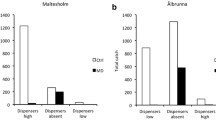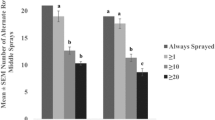Abstract
The effects of field aging (0–28 days) and pheromone loading rate on the longevity of red rubber septa loaded with the sex pheromone blend of the oriental fruit mothGrapholita molesta (Busck), were evaluated in North Carolina apple orchards in 2002. Separate field tests examined the influence of trap height and pheromone loading rate of rubber septa on trap catches of adultG. molesta males in an abandoned orchard. The loss of the major pheromone component, (Z)-8-dodecenyl acetate (Z8–12:OAc), from red rubber septa over a 4-week period exhibited a relatively constant release rate with 30, 100 and 300 µg pheromone. Trap catch was significantly higher in pheromone traps placed in the upper canopy than in those in the lower canopy. Pheromone traps baited with 100µg lures caught more moths compared with those loaded with 300 µg. There was no apparent relationship between pheromone trap catch and septa age, with trap catch appearing to be primarily a function ofG. molesta population density.
Similar content being viewed by others
References
Anshelevich, L., Kehat, M., Dunkelblum, E. and Greenberg, S. (1993) Sex pheromone traps for monitoring the honeydew moth,Cryptoblabes gnidiella: Effect of pheromone components, pheromone dose, field aging of dispenser, and type of trap on male captures.Phytoparasitica 21:189–198.
Anshelevich, L., Kehat, M., Dunkelblum, E. and Greenberg, S. (1994) Sex pheromone traps for monitoring the European vine moth,Lobesia botrana: Effect of dispenser type, pheromone dose, field aging of dispenser, and type of trap on male captures.Phytoparasitica 22:281–290.
Baker, T.C., Meyer, W. and Roelofs, W.L. (1981) Sex pheromone dosage and blend specificity of response by Oriental fruit moth males.Entomol. Exp. Appl. 30:269–279.
Brown, D.F. and McDonough, L.M. (1986) Insect sex pheromones: Formulation to increase the stability of conjugated dienes.J. Econ. Entomol. 79:922–927.
Butler, L.I. and McDonough, L.M. (1981) Insect sex pheromones: Evaporation rates of alcohols and acetates from natural rubber septa.J. Chem. Ecol. 7:627–632.
Cardé, A.M., Baker, T.C. and Cardé, R.T. (1979) Identification of a four-component sex pheromone of the Oriental fruit moth,Grapholita molesta (Lepidoptera: Tortricidae).J. Chem. Ecol. 5:423–427.
Cardé, R.T. and Minks, A.K. (1995) Control of moth pests by mating disruption: successes and constraints.Annu. Rev. Entomol. 40:559–585.
Charmillot, P.J. (1990) Mating disruption technique to control codling moth in Western Switzerland.in: Ridgeway, R.L., Silverstein, R.M. and Inscoe, M.N. [Eds.] Behavior-modifying Chemicals for Pest Management: Applications of Pheromones and Other Attractants. Marcel Dekker, New York, NY. pp. 165–182.
Daterman, G.E. (1982) Monitoring insects with pheromones: Trapping objectives and bait formulations.in: Kydonieus, A.F. and Beroza, M. [Eds.] Insect Suppression with Controlled Release Pheromone Systems. Vol. 1. CRC Press Inc., Boca Raton, FL, USA. pp. 195–212.
Flint, H.M., Butler, L.I., McDonough, L.M., Smith, R.L. and Forey, D.E. (1978) Pink bollworm: response to various emission rates of gossyplure in the field.Environ. Entomol. 7:57–61.
Gut, L.J. and Brunner, J.F. (1995) Pheromone lures for monitoring codling moth.Proc. Wash. State Hortic. Assoc. 91:235–237.
Howse, P.E., Stevens, L.D.R. and Jones, O.T. (1998) Insect Pheromones and Their Use in Pest Management. Chapman and Hall, London, UK.
Hull, A.L., Krawczyk, G. and Ellis, N. (2001) Management tactics for the Oriental fruit moth (Grapholita molesta) in Pennsylvania apple orchards.Pa Fruit News 81:23–27.
Kehat, M., Anshelevich, L., Dunkelblum, E., Fraishtat, P. and Greenberg, S. (1994) Sex pheromone traps for monitoring the codling moth: effect of dispenser type, and field aging of dispenser, pheromone dose and type of trap on male captures.Entomol. Exp. Appl. 70:55–62.
Kehat, M., Anshelevich, L., Dunkelblum, E. and Greenberg, S. (1994) Sex pheromone traps for monitoring the peach twig borer,Anarsia lineatella Zeller: Effect of pheromone components, pheromone dose, field aging of dispenser, and type of trap on male captures.Phytoparasitica 22:291–298.
Knight, A.L. (1995) Evaluating pheromone emission rate and blend in disrupting sexual communication of codling moth (Lepidoptera: Tortricidae).Environ. Entomol. 24:1396–1403.
Knight, A.L. (2002) A comparison of gray halo-butyl elastomer and red rubber septa to monitor codling moth (Lepidoptera: Tortricidae) in sex pheromone-treated orchards.J. Entomol. Soc. B.C. 99:123–132.
Kovanci, O.B., Schal, C., Walgenbach, J.F. and Kennedy, G.G. (2005) Comparison of mating disruption with pesticides for management of oriental fruit moth (Lepidoptera: Tortricidae) in North Carolina apple orchards.J. Econ. Entomol. 98:1248–1258.
Kovanci, O.B., Walgenbach, J.F. and Kennedy, G.G. (2004) Evaluation of extended-season mating disruption of the Oriental fruit mothGrapholita molesta (Busck) (Lep., Tortricidae) in apples.J. Appl. Entomol. 128:664–669.
Kovanci, O.B., Walgenbach, J.F., Kennedy, G.G. and Schal, C. (2005) Effects of application rate and interval on the efficacy of sprayable pheromone for mating disruption of the oriental fruit moth.Phytoparasitica 33:334–342.
Maitlen, J.C., McDonough, L.M., Moffitt, H.R. and George, D.A. (1976) Codling moth sex pheromone: Baits for mass trapping and population survey.Environ. Entomol. 5:199–202.
McNeil, J.N. (1991) Behavioral ecology of pheromone-mediated communication in moths and its importance in the use of pheromone traps.Annu. Rev. Entomol. 36:407–430.
Pree, D.J., Trimble, R.M., Whitty, K.J. and Vickers, P.M. (1994) Control of Oriental fruit moth by mating disruption in the Niagara Peninsula, Ontario.Can. Entomol. 126:1287–1299.
Quisumbing, A.R. and Kydonieus, A.F. (1989) Plastic laminate dispensers.in: Jutsum, A.R. and Gordon, R.S.F. [Eds.] Insect Pheromones in Plant Protection. John Wiley & Sons, New York, NY. pp. 149–163.
Rice, R.E. and Kirsch, P. (1990) Mating disruption of the Oriental fruit moth in the United States.in: Ridgeway, R.L., Silverstein, R.M. and Inscoe, M.N. [Eds.] Behavior-modifying Chemicals for Pest Management: Applications of Pheromones and Other Attractants. Marcel Dekker, New York, NY. pp. 193–211.
Rice, R.C., Weakley, C.V. and Jones, R.A. (1984) Using degree-day to determine optimum spray timing for the Oriental fruit moth (Lepidoptera: Tortricidae).J. Econ. Entomol. 77:698–700.
Riedl, H., Howell, J.F., McNally, P.S. and Westigard, P.H. (1986) Codling moth management, use and standardization of pheromone trapping systems.Univ. Calif. Div. Agric. Natural Resources Bull. 1918.
Robertson, S.P. and Hull, L.A. (2001) Areawide mating disruption of the Oriental fruit moth,Grapholita molesta, in Pennsylvania apples and peaches — 2001.Proc. 77th Cumberland-Shenandoah Fruit Workers’ Conf. (Winchester, VA, USA), pp. 53–59.
Roelofs, W.L., Cardé, R.T. and Tette, J. (1973) Oriental fruit moth attractant synergists.Environ. Entomol. 2:252–254.
Rothschild, G.H.L. (1981) Mating disruption of lepidopterous pests: Current status and future prospects.in: Mitchell, E.R. [Ed.] Management of Insect Pests with Semiochemicals. Plenum Press, New York, NY. pp. 207–228.
Rothschild, G.H.L. and Minsk, A.K. (1977) Some factors influencing the performance of pheromone traps for oriental fruit moth in Australia.Entomol. Exp. Appl. 22:171–182.
Rothschild, G.H.L. and Vickers, R.A. (1991) The biology, ecology and control of Oriental fruit moth.in: Van Der Geest, L.P.S. and Evenhuis, H.H. [Eds.] Tortricid Pests: Their Biology, Natural Enemies and Control. World Crop Pests. Elsevier, Amsterdam, the Netherlands. pp. 389–412.
Sanders, C.J. and Lucuik, G.S. (1996) Disruption of male Oriental fruit moth to calling females in a wind tunnel by different concentrations of synthetic pheromone.J. Chem. Ecol. 22:1971–1986.
SAS Institute (2001) SAS/STAT User’s Guide, Version 8. SAS Institute Inc., Cary, NC, USA.
Sziraki, G. (1979) Dispersion and movement activity of the Oriental fruit moth (Grapholita molesta Busck) in large scale orchards.Acta Phytopathol. Sci. Hung. 14:209–228.
Thomson, D.R., Gut, L.J. and Jenkins, J.W. (1999) Pheromones for insect control: Strategies and successes.in: Hall, F.R. and Menn, J.J. [Eds.] Methods in Biotechnology. Vol. 5, Biopesticides Use and Delivery. Humana Press Inc., Totowa, NJ, USA. pp. 385–412.
Vickers, R.A. and Rothschild, G.H.L. (1985) Control of the Oriental fruit moth,Cydia molesta (Busck) (Lepidoptera: Tortricidae) at a district level by mating disruption with synthetic female pheromone.Bull. Entomol. Res. 75:625–634.
Vrkoc, J., Konecny, K., Valterova, I. and Hrdý, I. (1988) Rubber substrates and their influence on isomerization of conjugated dienes in pheromone dispensers.J. Chem. Ecol. 14:1347–1358.
Wall, C. (1989) Monitoring and spray timing.in: Jutsum, A.R. and Gordon, R.S.F. [Eds.] Insect Pheromones in Plant Protection. John Wiley & Sons, New York, NY. pp. 39–60.
Weatherston, I. (1989) Alternative dispensers for trapping and disruption.in: Jutsum, A.R. and Gordon, R.S.F. [Eds.] Insect Pheromones in Plant Protection. John Wiley & Sons, New York, NY. pp. 249–275.
Author information
Authors and Affiliations
Corresponding author
Additional information
http://www.phytoparasitica.org posting May 14, 2006.
Rights and permissions
About this article
Cite this article
Kovanci, O.B., Schal, C., Walgenbach, F. et al. Effects of pheromone loading, dispenser age, and trap height on pheromone trap catches of the oriental fruit moth in apple orchards. Phytoparasitica 34, 252–260 (2006). https://doi.org/10.1007/BF02980952
Received:
Accepted:
Issue Date:
DOI: https://doi.org/10.1007/BF02980952




